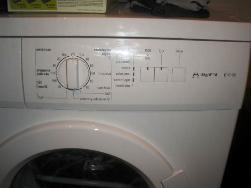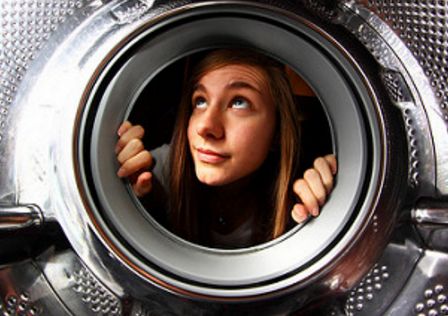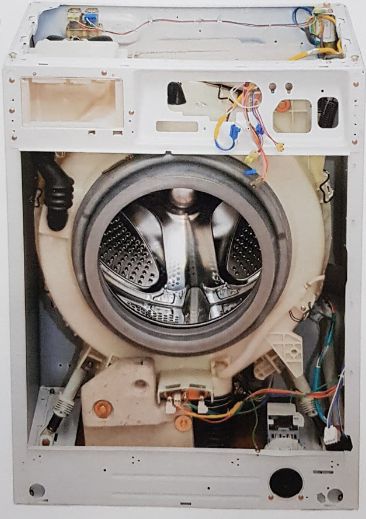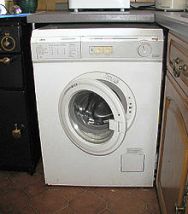Categories: Electrician Secrets, Safety precautions
Number of views: 202971
Comments on the article: 43
How to make the washing machine not shock
 Getting hit is very unpleasant. And the most painful are blows from those from whom you do not expect aggressive behavior, who, on the contrary, are called upon to create coziness and comfort in your home. For example, how do you like it if your washing machine starts to fight?
Getting hit is very unpleasant. And the most painful are blows from those from whom you do not expect aggressive behavior, who, on the contrary, are called upon to create coziness and comfort in your home. For example, how do you like it if your washing machine starts to fight?
Meanwhile, when included in a two-wire line, this is possible even for an absolutely functional washing machine. The reason is the features of the built-in mains filter located at the input of electrical power. The filter consists of two capacitors with a common point on the machine body. One capacitor connects the housing and the phase wire, and the other connects the housing and the neutral wire.

Manufacturers of modern washing machines naively believe that their creations will be included only in a three-wire electrical network with a separate protective conductor PE. In this case, there is nothing wrong with the two capacitors connecting the instrument case with phase and zero. Yes, the common wire acquires a potential of 110 volts, but its power is small, and the entire charge flows without consequences from the machine body to the protective neutral wire.
But reality is more complex and harsher. And in a two-wire line of 110 volts on the housing of the washing machine, you can easily feel it, having received a short-term, but very painful discharge with an unsuccessful touch.
And just do not think that the problem can be solved by disconnecting the common input filter wire from the housing. This will reduce the risk of electric shock, but not especially. After all, it is necessary to remember that the insulation of the wires laid inside the washing machine is subject to aging. This means that over time, the likelihood that the "phase" will be on the metal case increases. At first, this "phase" may be incomplete, but then we can get all the full 220 volts. And this despite the fact that the washing machine is most often installed in the bathroom - a room with increased danger!
“Tired” insulation is not an input filter for you, it can deliver unpleasant sensations when a weak capacitor is discharged. This is a direct threat to life and health.
That is why the housing of the washing machine must be included in the additional potential equalization system bathroom. A washing machine, a metal bath or shower, cold and hot water piping, a ventilation duct - all this must have a reliable electrical connection to each other. In this case, the simultaneous touch of two conductive structural elements will not threaten you with absolutely nothing.

But a potential equalization system alone is not enough for complete safety. Indeed, for electric shock, there is one more chain: the washing machine body - the human body - the floor of the room. And there are only two ways to keep current from this dangerous path: install in the power circuit of the washing machine RCD or ground its housing. The methods, of course, can be combined.
An RCD in a two-wire line will work a little differently. If there is no grounding, then during the breakdown of insulation on the case, leakage current will not occur. RCD, respectively, will not work. It will work only when a person touches the "body" of the washing machine. A small current will appear, to which our protective device should react. The fact that the protection will work only when touched is unpleasant. But, as they say, it’s better that way than nothing.
Since the current when touching the case will be small, the RCD rating should also not be very high - 30 milliamps maximum.For an old two-wire network, it is better to use an RCD mounted directly in the socket so that there are fewer problems with false alarms.
 Grounding the housing of the washing machine allows you to generally electrically bypass the human body with an indirect touch. If a breakdown of insulation occurs, the current simply flows into the ground electrode system, without any danger.
Grounding the housing of the washing machine allows you to generally electrically bypass the human body with an indirect touch. If a breakdown of insulation occurs, the current simply flows into the ground electrode system, without any danger.
But when performing protective grounding, difficulties can arise. Water pipes can not be used as grounding conductors. It is also forbidden to connect the zero working and zero protective conductors without a re-grounding device. As a result, if you have a two-wire network, you can only hope that the case drive electrical panel grounded. Otherwise, it will be necessary to part with the hopes of grounding the housing of the washing machine.
Find out how grounding is. switchboard at your entrance, it is possible in the operating organization - ZhEKe, HOA, etc.
Thus, we draw the following conclusions:
- If you have a three-wire line, and the washing machine started to “fight”, - check the integrity of the protective grounding circuit. Simple enough check voltage with a multimeter between the body of the machine and the "phase".
- If you have a two-wire line, you should try to arrange a separate grounding and a potential equalization system for the washing machine.
- If grounding cannot be performed, it is nevertheless necessary to arrange a potential equalization system in the bathroom and include an RCD of 30 mA or less in the circuit of the washing machine.
It should be noted that all of the above methods are best used when you are sure that the washing machine, in general, is working. It would be foolish to look for ways to solve the problem if the insulation of the lead-in cord is frayed in the machine itself and the “phase” directly hits the case. Yes, and RCD in this case, most likely, simply will not let the machine work at all. Therefore, if you began to receive electric shocks from your washing machine suddenly and recently, start with a detailed inspection of the culprit for obvious malfunctions.
At the time of preparation for resolving the issue with the “fighting” washing machine, you can try to insert its plug into the socket in a different way, that is, by reversing the zero and the “phase”. This is often effective if an insulation breakdown occurs in one of the wires relative to the load. If this wire is phase, then the device case begins to bite, and if it is zero, nothing happens. In a similar situation, to correct the situation at least temporarily, you can simply turn the plug over.
Alexander Molokov
Look on the topic:RCD in two-wire: to put or not to put?
See also at e.imadeself.com
:
